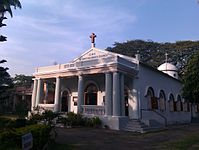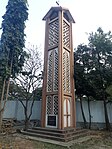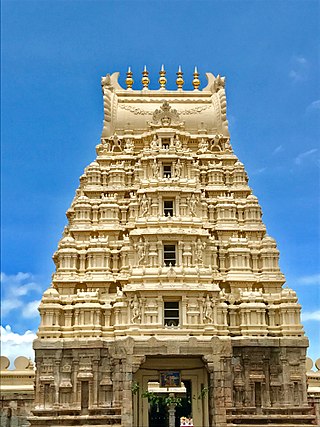
Srirangapatna is a town and headquarters of one of the seven Taluks of Mandya district, in the Indian State of Karnataka. It gets its name from the Ranganthaswamy temple consecrated at around 984 CE. Later, under the British rule the city was renamed to Seringapatnam. Located near the city of Mandya, it is of religious, cultural and historic importance.
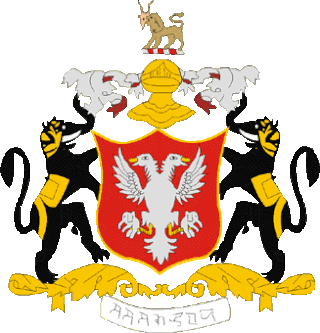
The Wadiyar dynasty, is a late-medieval/early-modern South Indian Hindu royal family of former kings of Mysore from the Urs clan originally based in Mysore city.

The Anglo-Mysore Wars were a series of four wars fought during the last three decades of the 18th century between the Sultanate of Mysore on the one hand, and the British East India Company, Maratha Empire, Kingdom of Travancore, and the Kingdom of Hyderabad on the other. Hyder Ali and his succeeding son Tipu fought the wars on four fronts: with the British attacking from the west, south and east and the Nizam's forces attacking from the north. The fourth war resulted in the overthrow of the house of Hyder Ali and Tipu, and the dismantlement of Mysore to the benefit of the East India Company, which took control of much of the Indian subcontinent.

Chamarajendra Wadiyar X was the twenty-third Maharaja of Mysore between 1868 and 1894.

Kempananjammanni Devi (1866–1934) was the Maharani of Mysore and later queen mother and regent of the Kingdom of Mysore.
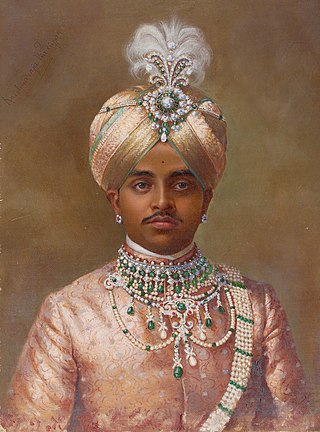
Krishnaraja Wadiyar IV (Kannada: ಶ್ರೀ ನಾಲ್ವಡಿ ಕೃಷ್ಣರಾಜ ಒಡೆಯರು; 4 June 1884 – 3 August 1940) was the twenty-fourth Maharaja of Mysore, reigning from 1902 until his death in 1940.

Jayachamarajendra Wadiyar, sometimes simply Jayachamaraja Wadiyar, was the twenty-fifth and last ruling Maharaja of Mysore, reigning from 1940 to 1950, who later served as the governor of Mysore until 1964 and as governor of Madras from 1964 to 1966.
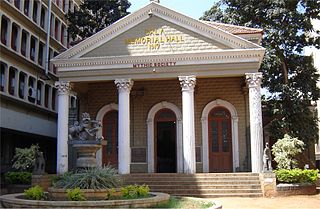
The Daly Memorial Hall, is a heritage building located in Bangalore, Karnataka that houses the Mythic Society. The Mythic society, founded in 1909, is a pioneering institution of Catholic-Indic studies in South India. Daly Memorial Hall, built at a cost of INR 24,783, was inaugurated on 25 July 1917 by the Kanteerava Narasimharaja Wadiyar (the Yuvaraja of Mysore. The Hall is named after Sir Hugh Daly, who served as the Resident of Mysore State and Chief Commissioner of Coorg.

Bangalore Fort began in 1537 as a mud fort. The builder was Kempe Gowda I, a vassal of the Vijaynagar Empire and the founder of Bangalore. Hyder Ali in 1761 replaced the mud fort with a stone fort and it was further improved by his son Tipu Sultan in the late 18th century. It was damaged during an Anglo-Mysore war in 1791. It still remains a good example of 18th-century military fortification. The army of the British East India Company, led by Lord Cornwallis on 21 March 1791 captured the fort in the siege of Bangalore during the Third Mysore War (1790–1792). At the time the fort was a stronghold for Tipu Sultan. Today, the fort's Delhi gate, on Krishnarajendra Road, and two bastions are the primary remains of the fort. A marble plaque commemorates the spot where the British breached fort's wall, leading to its capture. The old fort area also includes Tipu Sultan's Summer Palace, and his armoury. The fort has provided the setting for the treasure hunt in the book Riddle of the Seventh Stone.

KrishnacharyaPurnaiah, popularly known as DewanPurnaiah, was an Indian administrator, statesman, and strategist who served as the first dewan of Mysore from 1782 to 1811. He was instrumental in the restoration of the rule of the Kingdom of Mysore to the Wadiyar dynasty. He has the rare distinction of having served under a sultan and a maharaja: Tipu and Krishnaraja Wadiyar III, the two monarchs whom he collectively advised from 1782 to 1811.

The siege of Bangalore was a siege of the town and fortifications of Bangalore during the Third Anglo-Mysore War by forces of the British East India Company, led by Charles, Earl Cornwallis against a Mysorean garrison, while Tipu Sultan, Mysore's ruler, harried the camps and positions of the besiegers. Arriving before the town on 5 February 1791, Cornwallis captured the town by assault on 7 February, and after six weeks of siege, stormed the fortress on 21 March.
The Karnataka Central Diocese is one of the twenty-two dioceses of the Church of South India covering the central part of Karnataka.
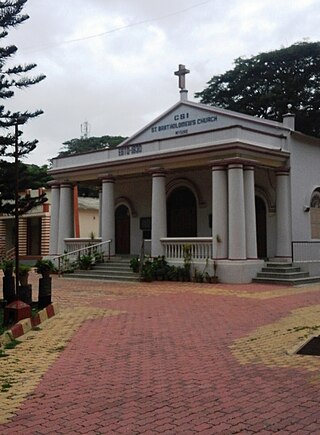
Karnataka Southern Diocese is one of the twenty-two dioceses of the Church of South India covering the southern part of Karnataka. The other Church of South India dioceses in Karnataka are Karnataka Northern Diocese and Central Karnataka Diocese.
Pulakeshi Nagara, commonly known as Fraser Town, is a suburb of Bangalore Cantonment, in Bangalore North-East, spread over 4 sq. km. It was established in 1906 and is named after Stuart Mitford Fraser (1864–1963), who was the tutor and guardian of Krishna Raja Wadiyar IV, Maharaja of Mysore. Fraser Town was established to de-congest the growing Bangalore Civil and Military Station. The foundation of Fraser Town was laid in August 1910 by Mrs. F J Richards, with a commemorative plaque on the corner of Coles Road and Mosque Road. Fraser Town is a residential and commercial suburb, the prominent roads being Promenade Road, Netaji Road, Madhavraya Mudaliar Road, Haines Road, Spencer Road, Wheeler Road, Mosque Road, etc. The suburb is known for its communal harmony with Hindus, Muslims and Christians living side by side in peace. Before being known as Fraser Town, the suburb was called Mootocherry by the locals. In 1988, the BBMP renamed Fraser Town as Pulakeshinagar, after Pulakeshin II who ruled the Deccan in the 7th century. However, the name has not caught on and continues to be popularly known as Fraser Town.
St. Andrew's Church, consecrated in 1866, is a Presbyterian church, located on Cubbon Road, Bangalore. Initially knows as St. Andrews's Kirk, it was a Church of Scotland church till 1959 when it became part of the Karnataka Central Diocese of the Church of South India. The church is named after Saint Andrew, the patron saint of Scotland. St Andrew's Church celebrated its 150 years anniversary on 20 November 2014.

Garrison Cemetery is located in Seringapatam, on the banks of the river Cauvery, about 300m from the Bangalore Mysore Highway. It has about 307 graves of the European officers killed in the final assault on Tippu Sultan in 1799, and their family members. Among the graves, there are 80 graves of the officers of the Swiss ‘de Meuron Regiment’, and the rest of the graves are their family members.

Mysore State Railway (MSR) was a railway company which was operated by the government of the Kingdom of Mysore. After India's constitution into a republic, MSR became part of Southern Railways of the government of India on 14 April 1951.

The Fort Church, Bangalore, was a church located within Bangalore Fort. The church was demolished to make place for the construction of the Vani Vilas Hospital. The Government of Mysore then allotted land in Chamrajpet for construction of a new church, St. Luke's Church, Bangalore. Early records refer to the Fort Church as the Drummer's Chapel, constructed by British soldiers after the fall of Tippu Sultan. The Fort Church, Bangalore was the first protestant church to be raised in Bangalore.

The Gumbaz at Srirangapattana is a Muslim mausoleum at the centre of a landscaped garden, holding the graves of Tippu Sultan, his father Hyder Ali (Middle) and his mother Fakhr-Un-Nisa. It was built by Tippu Sultan to house the graves of his parents. The British allowed Tippu to be buried here after his martyrdom in the Siege of Srirangapatna in 1799.

The Statue of Queen Victoria, Bangalore, is located at Queen's Park, next to Cubbon Park, Bangalore Cantonment, at the junction of 3 roads, at the border between the Cantonment and the Bangalore Pete. The statue was unveiled on 5 February 1906 by the then Prince of Wales, George Frederick Ernest Albert. The statue was raised out of funds raised by the residents of the Bangalore Civil and Military Station and contributions made by Krishna Raja Wadiyar IV, the Maharaja of Mysore. This Statue of Queen Victoria is one of the five of the original 50 statues of Queen Victoria which were installed in British India, to still stand at its original location. The statue has blossoms of jacaranda falling around. On the other end of Queen's Park is the Statue of King Edward VII.



